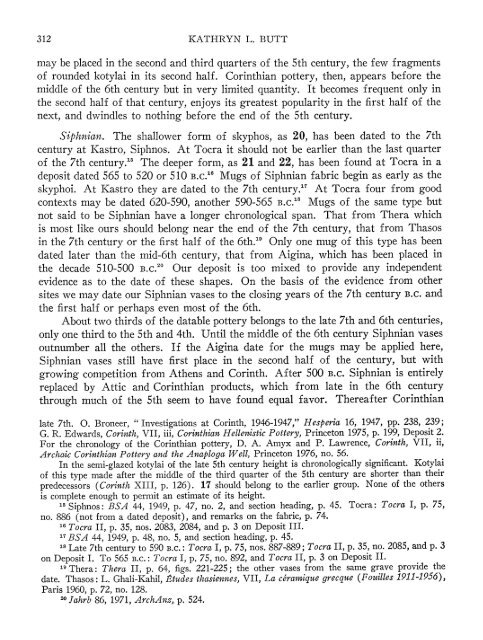a deposit of archaic and classical greek pottery - The American ...
a deposit of archaic and classical greek pottery - The American ...
a deposit of archaic and classical greek pottery - The American ...
Create successful ePaper yourself
Turn your PDF publications into a flip-book with our unique Google optimized e-Paper software.
312 KATHRYN L. BUTT<br />
may be placed in the second <strong>and</strong> third quarters <strong>of</strong> the 5th century, the few fragments<br />
<strong>of</strong> rounded kotylai in its second half. Corinthian <strong>pottery</strong>, then, appears before the<br />
middle <strong>of</strong> the 6th century but in very limited quantity. It becomes frequent only in<br />
the second half <strong>of</strong> that century, enjoys its greatest popularity in the first half <strong>of</strong> the<br />
next, <strong>and</strong> dwindles to nothing before the end <strong>of</strong> the 5th century.<br />
Siphnian. <strong>The</strong> shallower form <strong>of</strong> skyphos, as 20, has been dated to the 7th<br />
century at Kastro, Siphnos. At Tocra it should not be earlier than the last quarter<br />
<strong>of</strong> the 7th century.15 <strong>The</strong> deeper form, as 21 <strong>and</strong> 22, has been found at Tocra in a<br />
<strong>deposit</strong> dated 565 to 520 or 510 B.C."6 Mugs <strong>of</strong> Siphnian fabric begin as early as the<br />
skyphoi. At Kastro they are dated to the 7th century.17 At Tocra four from good<br />
contexts may be dated 620-590, another 590-565 B.C."8 Mugs <strong>of</strong> the same type but<br />
not said to be Siphnian have a longer chronological span. That from <strong>The</strong>ra which<br />
is most like ours should belong near the end <strong>of</strong> the 7th century, that from Thasos<br />
in the 7th century or the first half <strong>of</strong> the 6th." Only one mug <strong>of</strong> this type has been<br />
dated later than the mid-6th century, that from Aigina, which has been placed in<br />
the decade 510-500 B.C.20 Our <strong>deposit</strong> is too mixed to provide any independent<br />
evidence as to the date <strong>of</strong> these shapes. On the basis <strong>of</strong> the evidence from other<br />
sites we may date our Siphnian vases to the closing years <strong>of</strong> the 7th century B.C. <strong>and</strong><br />
the first half or perhaps even most <strong>of</strong> the 6th.<br />
About two thirds <strong>of</strong> the datable <strong>pottery</strong> belongs to the late 7th <strong>and</strong> 6th centuries,<br />
only one third to the 5th <strong>and</strong> 4th. Until the middle <strong>of</strong> the 6th century Siphnian vases<br />
outnumber all the others. If the Aigina date for the mugs may be applied here,<br />
Siphnian vases still have first place in the second half <strong>of</strong> the century, but with<br />
growing competition from Athens <strong>and</strong> Corinth. After 500 B.C. Siphnian is entirely<br />
replaced by Attic <strong>and</strong> Corinthian products, which from late in the 6th century<br />
through much <strong>of</strong> the 5th seem to have found equal favor. <strong>The</strong>reafter Corinthian<br />
late 7th. 0. Broneer, " Investigations at Corinth, 1946-1947," Hesperia 16, 1947, pp. 238, 239;<br />
G. R. Edwards, Corinth, VII, iii, Corinthian Hellenistic Pottery, Princeton 1975, p. 199, Deposit 2.<br />
For the chronology <strong>of</strong> the Corinthian <strong>pottery</strong>, D. A. Amyx <strong>and</strong> P. Lawrence, Corinth, VII, ii,<br />
Archaic Corinthian Pottery <strong>and</strong> the Anaploga Well, Princeton 1976, no. 56.<br />
In the semi-glazed kotylai <strong>of</strong> the late 5th century height is chronologically significant. Kotylai<br />
<strong>of</strong> this type made after the middle <strong>of</strong> the third quarter <strong>of</strong> the 5th century are shorter than their<br />
predecessors (Corinth XIII, p. 126). 17 should belong to the earlier group. None <strong>of</strong> the others<br />
is complete enough to permit an estimate <strong>of</strong> its height.<br />
15 Siphnos: BSA 44, 1949, p. 47, no. 2, <strong>and</strong> section heading, p. 45. Tocra: Tocra I, p. 75,<br />
no. 886 (not from a dated <strong>deposit</strong>), <strong>and</strong> remarks on the fabric, p. 74.<br />
16 Tocra II, p. 35, nos. 2083, 2084, <strong>and</strong> p. 3 on Deposit III.<br />
7 BSA 44, 1949, p. 48, no. 5, <strong>and</strong> section heading, p. 45.<br />
18 Late 7th century to 590 B.C.: Tocra I, p. 75, nos. 887-889; Tocra II, p. 35, no. 2085, <strong>and</strong> p. 3<br />
on Deposit I. To 565 B.C.: Tocra I, p, 75, no. 892, <strong>and</strong> Tocra II, p. 3 on Deposit II.<br />
19<strong>The</strong>ra: <strong>The</strong>ra II, p. 64, figs. 221-225; the other vases from the same grave provide the<br />
date. Thasos: L. Ghali-Kahil, tstudes thasiennes, VII, La ceramique grecque (Fouilles 1911-1956),<br />
Paris 1960, p. 72, no. 128.<br />
20 Jahrb 86, 1971, ArchAnz,, p. 524.

















